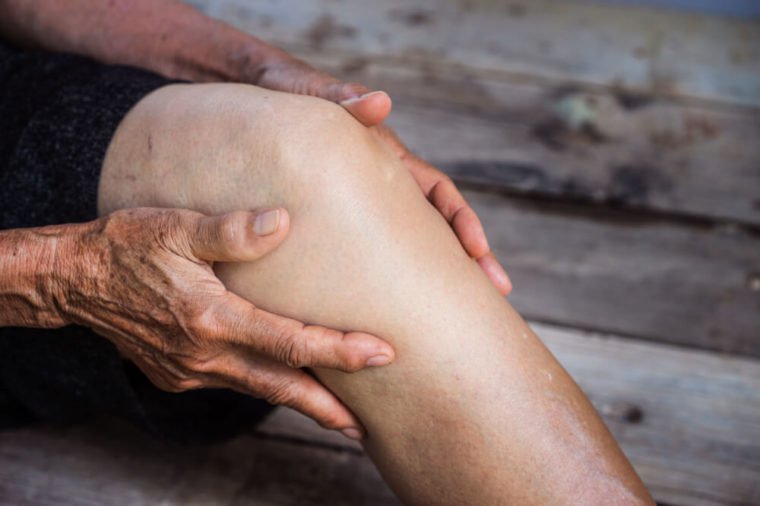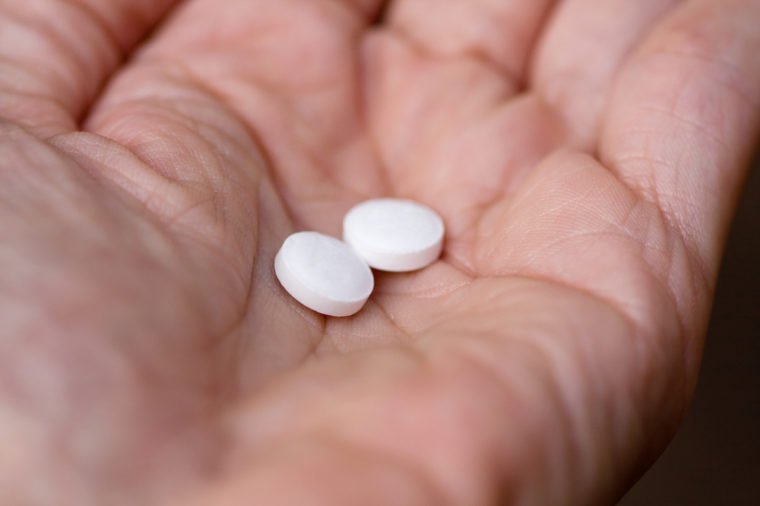Was it the weights you lifted at the gym? Or maybe your pillow is uncomfortable? Or could it be something more serious. Here’s how to tell.
What causes muscle pain?

You know that playing tennis all weekend will leave you sore on Monday or that putting in that extra tough workout in the gym is going to make you pay later when going down stairs (oh, your quads!). When you perform activity above and beyond what your body is accustomed to, “a byproduct of energy use is produced, called lactic acid, which is a chemical that causes soreness,” explains George Kannankeril, MD, a physical medicine and rehabilitation doctor at NorthShore University HealthSystem. Watch out for these hidden muscles that could be causing pain.
But it should go away

Muscle soreness is likely normal if you can pinpoint the reason for the ache (like you did a bunch of bicep curls yesterday) and if it dissipates over time. The pain should clear up after a couple days, or with one to two weeks at most, says Dr. Kannankeril. In the meantime, here are the best ways to treat muscle pain.
When to worry

Has muscle pain been lingering longer than two weeks? Is it a sharp pain versus discomfort or aching? Is it limiting your ability to carry out your normal day-to-day tasks? These are all symptoms that should tip you off that there may be something more going on. If this is happening, make an appointment with your doctor, advises Dr. Kannankeril.
It may be fibromyalgia

The neurologic condition causes pain and tenderness throughout the body, as well as fatigue and sleep problems, notes the American College of Rheumatology (ACR). You may also be able to point to an emotionally stressful situation that happened prior to the onset of pain, explains Dr. Kannankeril. “Fibromyalgia causes very specific patterns of pain, including on both sides of the body and above and below the waist,” he says. Avoid these things that only make the pain worse.
It can be arthritis

You may think of arthritis as affecting the joints, but you can also feel it in your muscles. The simple function of muscles is to contract or relax. “When there’s pain in an area, muscles will automatically contract as a protective measure,” says Dr. Kannankeril. If you have arthritis in your shoulder, for instance, your shoulder may go into painful muscle spasms.
It could be an infection

You’ve tried muscle soreness home remedies like these but nothing is easing the pain. What’s more, the sore area is red or inflamed and you have a fever. Your doctor may want to evaluate you for a possible infection, especially if there’s no reason (like starting marathon training) to have muscle pain in the first place. Make sure to eat these anti-inflammatory foods that reduce pain.
It may be Lyme disease

The bite of a black-legged tick may transmit Borrelia burgdorferi, bacteria that often causes the hallmark bulls eye-like rash. The problem is that the rash doesn’t always appear, so you have to be aware of the other early symptoms, including flu-like fever, fatigue, stiff neck, and aches. If you experience any of these and you’ve been hanging out in possible tick-laden places, such as hiking trails or campsites, talk to your doctor.
It could be rhabdomyolysis

Extreme workouts like CrossFit are trendy right now, but there’s a real danger of overdoing it: rhabdomyolysis, (dubbed rhabdo for short), a condition in which muscle tissue breaks down and releases a protein called myoglobin into the bloodstream, possibly causing kidney damage. If muscle stiffness and aches are accompanied by weakness and tenderness and dark urine, call your doctor ASAP or seek emergency treatment. Watch out for these fitness myths that can damage your health.
It may be an inflammatory condition

If you’re older than 65, your doctor may evaluate you for inflammatory muscle conditions, like polymyalgia rheumatica, says Dr. Kannankeril. PMR involves aching and stiffness in the upper arms, neck, lower back, and thighs notes the ACR. Symptoms can appear overnight and you may find that you suddenly have trouble getting dressed without help or that you can’t get in and out of your car. The cause is unknown and diagnosis can be tough; corticosteroids can help alleviate the stiffness that’s sidelining you.
You could have the flu

Last year was not a good year for the flu—it caused record-breaking levels of illness and hospitalization, according to the Centers for Disease Control and Prevention. If you have the flu, you may be hit with a sudden fever, aching muscles, chills and sweats, headache, fatigue, congestion, and a sore throat. As Popular Science notes in their exhaustive account of how the flu destroys your body, inflammatory proteins called cytokines break down muscle proteins, prompting soreness. If you’re at high risk for complications of the flu (for example, you’re 65 or older or are pregnant), see your doctor within 48 hours—you may be able to get an antiviral drug that can help you get better up to two days faster.
Look into lupus

Muscle pain affects two-thirds of those diagnosed with the chronic autoimmune condition lupus, according to the nonprofit Lupus LA. Problem is, many people have trouble getting diagnosed, as the disease can masquerade as a number of other conditions, including rheumatoid arthritis, Lyme, and even diabetes. One sign, says Lupus LA, is where the ache is: Lupus typically causes pain between the elbow and neck and knee and hip. Women ages 15 to 44 are most likely to be diagnosed. Watch out for these times your joint pain is something more serious.
It may be a medication side effect

Unfortunately, medications that are supposed to be keeping you well may be the reason you feel so awful. For instance, going on a new cholesterol medication may be the reason behind the onset of muscle pain. A doctor will rule out other potential causes; if the Rx is believed to be the culprit through a medical history or lab tests, they may consider prescribing a new drug within the same class or a different one, explains Dr. Kannankeril.
What to tell your doctor

There may be more to muscle pain than what meets the eye. “The funny thing about muscle pain is that it can accompany other painful conditions,” says Dr. Kannankeril. In short: Tell your doctor about any other symptoms that you’re currently experiencing or that may have started around the same time as the onset of your aches and pains. This includes fevers, fatigue, headaches, night sweats, trouble sleeping, constipation, or diarrhea. “Talk about any symptom that’s out of the ordinary for you,” he says. These are the pain symptoms you should never ignore.
Source: RD


















































